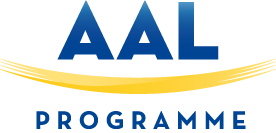VITAAL
Home » Success Stories » VITAAL
01. Introduction
The VITAAL project aimed to develop a personalised, evidence-based solution for promoting health and independence among older adults with cognitive deficits, increased fall risk or urinary incontinence. The project thus bridges the gap between gait analysis and intervention, offering unique and targeted training to improve quality of life.
02. Summary of project aims and objectives
VITAAL’s primary goal was to create a comprehensive, individualised training programme based on gait analysis, targeting older adults at risk of cognitive decline, falls, or urinary incontinence. The project aimed to leverage gait assessment to deliver precise interventions, promoting physical activity and enhancing mobility. The ultimate objective has been to foster independent living while reducing healthcare burdens associated with geriatric conditions.
03. Product development and key features
Product Name:
Product Type
- Physical product
Key features:
Dividat Senso Play:
- Interactive training device focusing on physical and cognitive exercises.
Launch years:
- Dividat Senso Play: 2021
- Dividat Senso Assessment: 2022
Dividat Senso Assessment:
- Evaluation tool integrated with Senso Play to assess physical and cognitive capabilities.
- Personalised exercise programmes that use multidirectional steps, jumps, and weight shifts.
- Uses a pressure-sensitive platform to measure physical force and stability.
- Provides training games and cognitive tasks to improve mobility and mental function.
Functional categories:
- Maintain/improve physical activity levels
- Support formal carers
- Detect early risks
Achievements:
- Gained visibility through published research (e.g., collaboration with KU Leuven).
- Integrated findings from user testing to develop market-ready products.
04. Partners
Number of Partners: 7
- Dividat AG, SME, Switzerland (Coordinator)
- Associação Fraunhofer Portugal Research, R&D, Portugal
- ETH Zürich, R&D, Switzerland
- Université de Montreal, R&D, Canada
- KU Leuven, End-user, Belgium
- ProCare, SME, Belgium
- Physios SPArtos, SME, Switzerland
05. Impact of participating in the AAL Project
Key takeaways
- Improved product viability through user engagement and testing.
- Accelerated product development and time-to-market due to AAL funding.
- Enhanced visibility and reputation, especially through academic publications.
Impacts on partners
- Dividat expanded its network and strengthened collaboration with partners like KU Leuven.
- ProCare’s business growth was supported by AAL participation, leading to new projects and partnerships.
- Dividat's visibility increased significantly through the publication of research on Senso products.
06. Main learnings from developing a solution through AAL
Technological advancements:
- Transition from motion sensors to pressure-sensitive devices for accurate movement tracking.
- Realisation that gait analysis combined with personalised training can significantly benefit cognitive health.
User insights:
- Found that the product was more beneficial for older adults with cognitive impairments than those with incontinence.
- Adjusted the product features based on feedback from end-users and healthcare professionals.
Organisational impact:
- AAL project participation accelerated the conceptualisation and practical development of Dividat Senso products.
- Gained essential insights into business model development and market acceptance.
07. Impact on networking and collaboration
Networking impact
- Strengthened ties with academic and industry partners, including KU Leuven and ProCare.
- Expanded international collaboration, with new connections in Canada and the EU.
Collaboration:
- ProCare became the official distributor for the Senso products in Belgium, the Netherlands, and Luxembourg.
- Continued joint projects with universities and industry partners for future healthcare solutions.
08. Perceived benefits of participating in AAL Support Actions
AAL2Business and AAL Forum participation:
- Strengthened knowledge of AAL programme goals and practices.
- Improved business model development and investor engagement skills.
- Broadened professional networks and shared knowledge with other AAL projects.
Key learning:
- Participation helped develop strategic business plans and enhanced the product’s commercial potential.
09. How AAL supported the project in solution development and market adoption
User involvement:
- Valuable feedback from older adults and caregivers during product testing.
- Identified critical functional requirements through real-world use cases.
Product complexity reduction:
- Simplified product features for better user acceptance.
Awareness and support:
- Publication of scientific papers increased credibility.
- Collaboration with healthcare institutions improved visibility and product validation.
10. Challenges encountered
Commercial and market barriers:
- Regulatory challenges in healthcare markets.
- Differences in healthcare financing and reimbursement between countries.
Financial challenges:
- Need for continued funding to support commercialisation.
How AAL helped:
- Provided funding to accelerate product development.
- Facilitated market entry strategies through business support activities.
11. Actions needed to launch product
Market development:
- Strengthen distribution networks through partnerships.
- Explore integration with healthcare insurance to enhance affordability.
Product proof:
- Conduct long-term clinical validation studies.
Funding and support:
- Secure investment for scaling and international expansion.
Awareness:
- Increase outreach to healthcare institutions and caregiver organizations.
12. Next steps
End-users:
- Target older adults with gait impairments and cognitive issues in care facilities and rehabilitation centres.
Expected impact on end-users:
- Improved mobility, cognitive function, and independence.
- Reduced healthcare burden through preventive interventions.
Target paying customers:
- Hospitals, care homes, rehabilitation centres, and physiotherapy clinics.
Growth projections:
- Expand geographical reach, particularly in Europe and North America.
- Strengthen partnerships with local distributors to improve market access.
- Diversify applications to include home-based training and rehabilitation.
